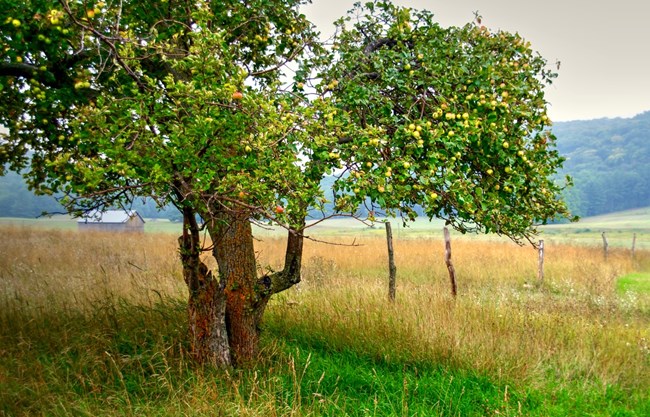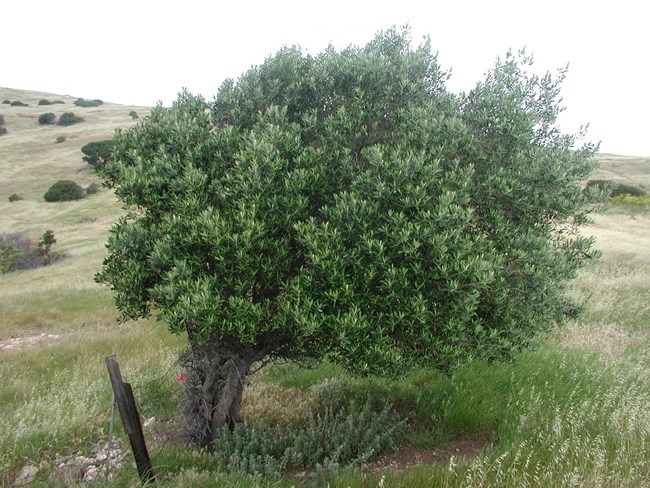Last updated: October 20, 2022
Article
Orchard History: Orchard Specialization and Industrialization, 1881-1945
This article is an excerpt from Part I, Chapter 3 of Fruitful Legacy: A Historic Context of Orchards in the United States, with Technical Information for Registering Orchards in the National Register of Historic Places.
Commercialization, scientific, and technological development, and regionalism
The evolution of orchards from 1881 to 1945 was fueled by technological and scientific discovery, leading to the professional and commercial development of the orchard industry. The most important changes from a cultural resource management perspective were transformations in the form, shape, and layout of orchard trees and a dramatic reduction in the number of varieties grown. These transformations were influenced by the involvement of the federal government in horticultural development through the creation of the United States Department of Agriculture and the establishment of agricultural experiment stations in every state.

NPS / Jacob Frank

NPS
During this period, orchard tree form changed from a five-foot-tall trunk to a less than three-foot- tall trunk; tree shape changed from an unpruned, natural state to either a central leader or open-bowl pruning style, and orchard layout was expanded to greater spacing. The layout of apple and pear orchards varied from 30 by 30 feet spacing to as much as 40-50 by 40-50 feet, and for tighter-spaced fruits such as peach, plum, and cherry, the layout was changed from a square to a rectangular arrangement. The layout changes enabled greater access for new machinery and equipment and increased the yield from mature trees.
The dramatic decrease in the number of varieties being grown was due to a process of selection for commercial fitness. Commercial criteria were refined during the period to incorporate factors that promoted high yields and durability of harvested fruit. As a result, the number of varieties of all orchard fruits grown was pared from many hundreds to tens. At the end of the period, most orchard fruit species were represented by just ten widely-grown commercial varieties. For most fruit species, the top ten varieties were dominated by one variety with the greatest commercial value and most widespread planting. Baldwin and Ben Davis were the most important commercial varieties of apples in the early 1900s, but these were rapidly superseded by McIntosh for Baldwin and Red Delicious for Ben Davis. The development of Red Delicious during this period had an enormous impact on apple growing, resulting in greater profitability for the industry, great fashionability of red apples, greater ubiquity of a single variety, and further obsolescence of superseded varieties.
The Bartlett variety dominated the pear industry, with New York and California as the greatest producers. Meanwhile, an expanding industry in the Pacific Northwest favored Anjou and Bosc varieties. Peach growing was ubiquitous with many local varieties remaining important, though Elberta became the most dominant and widely-grown variety. For cherry and plum, commercial growing became regionalized, similar to pears. Sour cherry production became centered in the upper Midwest, where Montmorency was the dominant variety, and sweet cherry production was taken over by the Pacific Northwest where Bing was the most important variety. Plum growing was not dominated by a single variety, but specialization occurred in certain regions. Japanese and European plum growing centered on the West Coast, American varieties were grown in the Midwest and the South, and European varieties were grown to a less extent in the eastern states.

NPS
Citrus, olive, and nut species were the only orchard fruits to have a net increase in their number of varieties during this period. These industries were born and established during the period as a result of the development or importation of varieties and breakthroughs in the horticultural techniques of propagation and transplanting. The citrus, olive, and nut industries also became highly regionalized with citrus centered in Florida and California and olive production in California. With commercial nut orchards, pecan production was centered in Texas, almonds and English walnuts in California, and European hazelnuts in the Pacific Northwest.
The number of fruit trees and orchards fell dramatically during the period, with all but the West Coast losing orchards to increasing urbanization. Approximately 50 percent of the fruit trees that existed in 1880 were gone by 1930, though the great paring down in the number of orchards was paralleled by a rise in specialized, commercial orchards, managed by growers rather than farmers. Technologies that buoyed the development of commercial orchards included a nationwide network of railroads and then later a national system of roads, growth in canning technology and irrigation systems, and the discovery of mechanical refrigeration and cold storage. Scientific breakthroughs included the discovery of disease organisms and the development of the first pesticides for orchard pest control.
Orchard management became more elaborate with the standard practices of pruning, spraying, fertilizing, and cultivation. Packing sheds were added to western orchards, and packing containers and advertising were designed to increase profitability. The Progressive Era brought regulatory challenges for growers and the Great Depression brought economic hardship, both resulting in greater cooperation between growers through the development of growers' cooperatives and marketing commissions.
Packing sheds were lost from western orchards as centralized fruit handling facilities were created, and still more orchards were abandoned during the Depression years when almost no growers turned a profit. The Civilian Conservation Corps contributed to the removal of orchards between 1933 and 1941 through reclamation efforts, but also served to create orchards by replanting commemorative orchards at national historic sites.
At the end of the period, the apple variety Golden Delicious was steadily gaining popularity with growers as a potentially lucrative new yellow apple and a good pollenizer for the dominant, self-sterile Red Delicious variety. Dwarf fruit trees were becoming popular with urban and suburban homeowners with fruit and vegetable gardens, and intense research was underway to move the industry towards smaller trees and intensive orchard management. Full-size, standard trees remained the norm for all commercial orchard fruits, although the need for labor savings through more accessible orchard trees was becoming very evident.

NPS / S. Dolan
